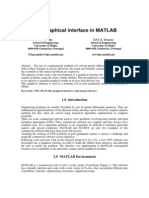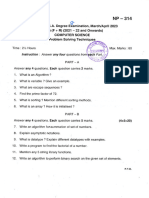0 ratings0% found this document useful (0 votes)
432 viewsAldep
Aldep
Uploaded by
Sankalp BhatiyaALDEP is an automated layout design program that takes basic facility and department data as input and builds a layout by successively placing departments based on their relationship information and minimum closeness preferences. It uses a multi-step procedure to initially place departments randomly and then select subsequent departments to maximize closeness according to a relationship chart. The program outputs the final layout and calculates a total score based on the closeness ratings of neighboring departments.
Copyright:
Attribution Non-Commercial (BY-NC)
Available Formats
Download as PPTX, PDF, TXT or read online from Scribd
Aldep
Aldep
Uploaded by
Sankalp Bhatiya0 ratings0% found this document useful (0 votes)
432 views10 pagesALDEP is an automated layout design program that takes basic facility and department data as input and builds a layout by successively placing departments based on their relationship information and minimum closeness preferences. It uses a multi-step procedure to initially place departments randomly and then select subsequent departments to maximize closeness according to a relationship chart. The program outputs the final layout and calculates a total score based on the closeness ratings of neighboring departments.
Original Description:
Aldep_ppt
Copyright
© Attribution Non-Commercial (BY-NC)
Available Formats
PPTX, PDF, TXT or read online from Scribd
Share this document
Did you find this document useful?
Is this content inappropriate?
ALDEP is an automated layout design program that takes basic facility and department data as input and builds a layout by successively placing departments based on their relationship information and minimum closeness preferences. It uses a multi-step procedure to initially place departments randomly and then select subsequent departments to maximize closeness according to a relationship chart. The program outputs the final layout and calculates a total score based on the closeness ratings of neighboring departments.
Copyright:
Attribution Non-Commercial (BY-NC)
Available Formats
Download as PPTX, PDF, TXT or read online from Scribd
Download as pptx, pdf, or txt
0 ratings0% found this document useful (0 votes)
432 views10 pagesAldep
Aldep
Uploaded by
Sankalp BhatiyaALDEP is an automated layout design program that takes basic facility and department data as input and builds a layout by successively placing departments based on their relationship information and minimum closeness preferences. It uses a multi-step procedure to initially place departments randomly and then select subsequent departments to maximize closeness according to a relationship chart. The program outputs the final layout and calculates a total score based on the closeness ratings of neighboring departments.
Copyright:
Attribution Non-Commercial (BY-NC)
Available Formats
Download as PPTX, PDF, TXT or read online from Scribd
Download as pptx, pdf, or txt
You are on page 1of 10
AUTOMATED LAYOUT DESIGN PROGRAM (ALDEP)
ALDEP is basically a construction algorithm, but it can also be used to evaluate two layouts
It uses basic data on facilities & builds a layout by successively placing the layout using relationship information b/w the departments
25/03/2013
lec no. 13 & 14
AUTOMATED LAYOUT DESIGN PROGRAM (ALDEP)cont
Basic Inputs to ALDEP: 1. Length & width of facility 2. Area of each department 3. Minimum Closeness Preference (MCP) Value 4. Sweep width 5. Relationship chart showing the closeness rating 6. Location & size of any restricted area
25/03/2013 lec no. 13 & 14 2
AUTOMATED LAYOUT DESIGN PROGRAM (ALDEP)cont
Procedure Adapted for using ALDEP : Step#01: Input the following
1. 2. 3. 4. 5. 6.
25/03/2013
Length & width of facility Area of each department Minimum Closeness Preference (MCP) Value Sweep width Relationship chart showing the closeness rating Location & size of any restricted area
lec no. 13 & 14 3
AUTOMATED LAYOUT DESIGN PROGRAM (ALDEP)cont
Procedure Adapted for using ALDEP : Step#2: One department is selected randomly & placed in the layout Step#3: In this step, the algorithm uses minimum closeness required b/w departments for the selection of departments to be placed with an earlier placed department. Select the department having maximum closeness rating. If there is no department having minimum closeness preference then any dept that remains to be placed is selected
25/03/2013 lec no. 13 & 14 4
AUTOMATED LAYOUT DESIGN PROGRAM (ALDEP)cont
Procedure Adapted for using ALDEP : Step#4: If all the departments are placed in the layout, go to step#5. else go to step#3 Step#5: Compute the total score of the layout Step#6: If the total score required is acceptable score, then go to step#7, else go to step#2 Step#7: Print the current layout & the corresponding score
25/03/2013 lec no. 13 & 14 5
ALDEP: ILLUSTRATIVE Example
Example 2: Develop a layout for the following problem. Layout & area requirements are shown in Table2.1
Department 1 2 Area (sq.ft) 1200 800 No. of unit squares 30 20
3
4 5 6
600
1200 800 1200
15
30 20 30
7
Total
1200
7000
30
175
Table.2.1
25/03/2013 lec no. 13 & 14 6
ALDEP: ILLUSTRATIVE Example
Solution: Assume One square in the layout to be equal 40 sq.ft.
No. of unit squares for dept = dept.area in sq.ft/area per square Let the size of layout be 15x12, & the sweep width be 2 (this means that we will fill 2 columns simultaneously). The Relationship chart for the example is follows:
Department 1 2 3 4 5 6 7
25/03/2013
1 E O I O U U
2 E U E I I U
3 O U U U O U
lec no. 13 & 14
4 I E U I U U
5 O I U I A I
6 U I O U A E
7 U U U U I E
7
ALDEP: ILLUSTRATIVE Example
Solution: Let department 2 be selected. Number of unit squares in dept 1 be 20. now 20 square units are filled in 15 x 12 grid as shown in table2.2 Since minimum closeness b/w departments required for selection of department is I=4 Scan the relationship chart randomly to find the departments having closeness rating of 4 or greater with department 2
25/03/2013 lec no. 13 & 14 8
ALDEP: ILLUSTRATIVE Example
Solution: For the above case closeness rating for the pairs (1-2)=16, (2-5)=4, & (2-6)=4 Select any dept, say dept 1. Place dept 1 in the layout in a serpentine pattern as shown in table 2.3 Repeat the above procedure to get the final layout as shown in table 2.4
25/03/2013 lec no. 13 & 14 9
ALDEP: ILLUSTRATIVE Example
Solution: After the final layout is obtained, the score is calculated. The score is the sum of the closeness ratings of all the neighboring departments, see table 2.5 From the above layout the score is 2 x110 = 220 A further iteration should be carried out to check if a better score can be achieved
25/03/2013 lec no. 13 & 14 10
You might also like
- Practice Questions for Tableau Desktop Specialist Certification Case BasedFrom EverandPractice Questions for Tableau Desktop Specialist Certification Case BasedRating: 5 out of 5 stars5/5 (1)
- (Aldep) Automated Layout Design ProgramDocument7 pages(Aldep) Automated Layout Design ProgramKrishan Kant50% (2)
- P66 M1 B12 eDocument132 pagesP66 M1 B12 eVinay100% (1)
- Operational MNGMNTDocument14 pagesOperational MNGMNTfufaharom10No ratings yet
- Computerized Relationship Layout Planning (Corelap) : Consists ofDocument10 pagesComputerized Relationship Layout Planning (Corelap) : Consists ofSadiaAslamNo ratings yet
- Computerized Plant LayoutDocument39 pagesComputerized Plant LayoutPraveen JayachandrakumarNo ratings yet
- Mod 4Document88 pagesMod 4Sudheesh SNo ratings yet
- OM AssignmentDocument11 pagesOM Assignmentfufaharom10No ratings yet
- Facility Design-Week 9-Computerized Layout PlanningDocument40 pagesFacility Design-Week 9-Computerized Layout PlanningNithyapriya VeeraraghavanNo ratings yet
- Computerized Layout PlanningDocument31 pagesComputerized Layout PlanningAlyaa Mohammad Younes100% (1)
- MAT116E Introduction 2021fallDocument26 pagesMAT116E Introduction 2021fallUmut KutluNo ratings yet
- Lebadesus-Francis M.-Matlab-As-CalculatorDocument12 pagesLebadesus-Francis M.-Matlab-As-CalculatorFrancis LebadesusNo ratings yet
- Problem SolvingDocument90 pagesProblem SolvinghsamailaNo ratings yet
- Construction AlgorithmsDocument66 pagesConstruction AlgorithmsTIRichard Fabiano HandokoNo ratings yet
- Lab Project: Shift-and-Add Multiplication Circuit With StorageDocument5 pagesLab Project: Shift-and-Add Multiplication Circuit With StoragesneophNo ratings yet
- Presentation 11Document40 pagesPresentation 11Anam ShoaibNo ratings yet
- Craft by SMKDocument19 pagesCraft by SMKSai Mani KrishnaNo ratings yet
- Cse-112-Psuc Labmanual Jan2013Document16 pagesCse-112-Psuc Labmanual Jan2013Anisha BhowmickNo ratings yet
- S&s Lab ManualDocument93 pagesS&s Lab Manualtauseef124No ratings yet
- Lab ManualDocument85 pagesLab ManualhotboangaNo ratings yet
- Ch05 Facilities LayoutDocument45 pagesCh05 Facilities LayoutPhương UyênNo ratings yet
- Lab Manual Daa Ad3351 Aids III Sem Regulation 2021Document48 pagesLab Manual Daa Ad3351 Aids III Sem Regulation 2021adhi1437adhiNo ratings yet
- Design and Implementation of Floating Point Multiplier Using Wallace and Dadda AlgorithmDocument6 pagesDesign and Implementation of Floating Point Multiplier Using Wallace and Dadda AlgorithmInternational Journal of Application or Innovation in Engineering & ManagementNo ratings yet
- LP Using Assignment MethodDocument15 pagesLP Using Assignment MethodHERNANDO REYESNo ratings yet
- Unit4 ORDocument6 pagesUnit4 ORanishvanchaNo ratings yet
- Numeco 3001b 05 Bagundang, Almanzur S.Document14 pagesNumeco 3001b 05 Bagundang, Almanzur S.21101002-studentNo ratings yet
- Implementation of Modified Booth Algorithm (Radix 4) and Its Comparison With Booth Algorithm (Radix-2)Document18 pagesImplementation of Modified Booth Algorithm (Radix 4) and Its Comparison With Booth Algorithm (Radix-2)THIRUCHANOORU SREENATHNo ratings yet
- MatLab Exam 1 Problem Portion Feb 29 2024-1Document4 pagesMatLab Exam 1 Problem Portion Feb 29 2024-1gerardoruiz1528No ratings yet
- Geospatial Modeling EnvironmentDocument31 pagesGeospatial Modeling EnvironmentMas Inoenk Nurdin SulistiyonoNo ratings yet
- UNIT 1 - Program Logic DevelopmentDocument36 pagesUNIT 1 - Program Logic DevelopmentDwaranath SrinivasanNo ratings yet
- Sammelmappe UebungenDocument14 pagesSammelmappe UebungenzemabderNo ratings yet
- CH 14Document4 pagesCH 14maherkamelNo ratings yet
- GRP 21Document18 pagesGRP 21tarun_fiemNo ratings yet
- Craft and AldepDocument29 pagesCraft and AldepdeekshithNo ratings yet
- EE 2301 Circuit Analysis I: Laboratory ManualDocument85 pagesEE 2301 Circuit Analysis I: Laboratory ManualPriyanka DeyNo ratings yet
- Programming With Mathcad PrimeDocument13 pagesProgramming With Mathcad PrimeClaudiu Popescu67% (3)
- Initial Layout Recovered)Document43 pagesInitial Layout Recovered)tmandariNo ratings yet
- Computer Science Final Exam (2013)Document18 pagesComputer Science Final Exam (2013)Chantal RamezNo ratings yet
- Flowchart AlgorithmDocument13 pagesFlowchart AlgorithmSrija ReddyNo ratings yet
- Lab 1 Introduction and Top-SPICE DemoDocument10 pagesLab 1 Introduction and Top-SPICE Demochrisdp23No ratings yet
- HW 3Document4 pagesHW 3asdf2fdweffNo ratings yet
- CFD Graphical Interface in MATLAB PDFDocument7 pagesCFD Graphical Interface in MATLAB PDFAhmadreza AminianNo ratings yet
- Special Assignment 2: General InformationDocument2 pagesSpecial Assignment 2: General InformationharshaNo ratings yet
- Excel Solver ThiebookDocument7 pagesExcel Solver ThiebookMaria CindaNo ratings yet
- Hollier MethodDocument33 pagesHollier MethodalagurmNo ratings yet
- Cs433 Sp12 Midterm SolDocument9 pagesCs433 Sp12 Midterm SolSwatiMeenaNo ratings yet
- Qadm PPT NewDocument25 pagesQadm PPT NewAarti AsraniNo ratings yet
- Map Reduce-LO2Document62 pagesMap Reduce-LO2Kai EnezhuNo ratings yet
- Semester Project - Section A: Problem StatementDocument3 pagesSemester Project - Section A: Problem StatementGM IqbalNo ratings yet
- LAB 3 09102020 124048pm 04112021 085029am 10102022 052033pmDocument5 pagesLAB 3 09102020 124048pm 04112021 085029am 10102022 052033pmMaryam RahimNo ratings yet
- AutoCAD 2016 and AutoCAD LT 2016 No Experience Required: Autodesk Official PressFrom EverandAutoCAD 2016 and AutoCAD LT 2016 No Experience Required: Autodesk Official PressRating: 4 out of 5 stars4/5 (1)
- AutoCAD 2015 and AutoCAD LT 2015: No Experience Required: Autodesk Official PressFrom EverandAutoCAD 2015 and AutoCAD LT 2015: No Experience Required: Autodesk Official PressNo ratings yet
- Projects With Microcontrollers And PICCFrom EverandProjects With Microcontrollers And PICCRating: 5 out of 5 stars5/5 (1)
- Solidworks 2018 Learn by Doing - Part 3: DimXpert and RenderingFrom EverandSolidworks 2018 Learn by Doing - Part 3: DimXpert and RenderingNo ratings yet
- IT-705 (EL-II) Artificial Intelligence (Prolog) : Charotar Institute of Technology - ChangaDocument16 pagesIT-705 (EL-II) Artificial Intelligence (Prolog) : Charotar Institute of Technology - ChangaSankalp BhatiyaNo ratings yet
- Development of Computer-Aided Design Software For Jigs and Fixtures For Drilling FlangesDocument6 pagesDevelopment of Computer-Aided Design Software For Jigs and Fixtures For Drilling FlangesSankalp BhatiyaNo ratings yet
- Arranging Machines in A GT Cell: - Method To Organize The Machines Into The Most LogicalDocument6 pagesArranging Machines in A GT Cell: - Method To Organize The Machines Into The Most LogicalSankalp BhatiyaNo ratings yet
- Material Requirement Planning (MRP I)Document60 pagesMaterial Requirement Planning (MRP I)Sankalp BhatiyaNo ratings yet
- Introduction To Physiotherapy: Prepared By, Dr. Sonia Bhatia (P.T.)Document25 pagesIntroduction To Physiotherapy: Prepared By, Dr. Sonia Bhatia (P.T.)Sankalp BhatiyaNo ratings yet
- Presses N Press Work 1Document15 pagesPresses N Press Work 1Sankalp BhatiyaNo ratings yet
- 51 FullDocument5 pages51 FullSankalp BhatiyaNo ratings yet
- Propeller ShaftDocument7 pagesPropeller ShaftSankalp BhatiyaNo ratings yet
- Ai Hex HR4 SS - Rev001Document1 pageAi Hex HR4 SS - Rev001Sankalp BhatiyaNo ratings yet
- 06 Roma06Document14 pages06 Roma06Sankalp BhatiyaNo ratings yet
- Cse 05 KCS-503 SJDocument2 pagesCse 05 KCS-503 SJshiv.2125csit1121No ratings yet
- SAP PI ContextDocument11 pagesSAP PI ContextDdesperadoNo ratings yet
- Floyd WarshallDocument6 pagesFloyd WarshallciaoasdasdNo ratings yet
- Data Structures - Final Proyect 1Document8 pagesData Structures - Final Proyect 1Jorge Isaac Merla HernándezNo ratings yet
- Machine Learning Algorithms From ScratchDocument9 pagesMachine Learning Algorithms From Scratchmcs23007No ratings yet
- Unit 2 CA209Document29 pagesUnit 2 CA209Farah AsifNo ratings yet
- Lecture15 (Presorting, BST)Document46 pagesLecture15 (Presorting, BST)DeependraNo ratings yet
- The International Journal of Engineering and Science (The IJES)Document6 pagesThe International Journal of Engineering and Science (The IJES)theijesNo ratings yet
- C Program To Delete All Nodes of Singly Linked List - CodeforwinDocument1 pageC Program To Delete All Nodes of Singly Linked List - CodeforwinPratikRoyNo ratings yet
- 8 Problem Solving Techniques March 2023Document2 pages8 Problem Solving Techniques March 2023Meena VinothNo ratings yet
- Chapter 2 Search TechniquesDocument89 pagesChapter 2 Search Techniquesrahul.s221054101No ratings yet
- Data Structures and Algorithms: (CS210/ESO207/ESO211)Document24 pagesData Structures and Algorithms: (CS210/ESO207/ESO211)Moazzam HussainNo ratings yet
- Midterm 2 Practice B KeyDocument8 pagesMidterm 2 Practice B KeysalmanshokhaNo ratings yet
- Assignment 3Document5 pagesAssignment 3Ahmed EidNo ratings yet
- Ai Lab Manual Artificial Intelligence Lab Using Python (LC-CSE-326G)Document29 pagesAi Lab Manual Artificial Intelligence Lab Using Python (LC-CSE-326G)Kiruthiga RajendiranNo ratings yet
- Amortized Analysis-2Document15 pagesAmortized Analysis-2sushilnayakNo ratings yet
- Nandini Walia Learing ReportDocument3 pagesNandini Walia Learing ReportAbhinav MauryaNo ratings yet
- Program-21: To Implement A Stack and Manage DataDocument16 pagesProgram-21: To Implement A Stack and Manage DataShivam Kumar singhNo ratings yet
- Lec 9+10 Divide and Conqure Quick Sort AlgorithmDocument9 pagesLec 9+10 Divide and Conqure Quick Sort AlgorithmDaud JavedNo ratings yet
- Python ProgramsDocument6 pagesPython ProgramsdsreNo ratings yet
- 3 4-7Document2 pages3 4-7Kricel MaqueraNo ratings yet
- Convolutional Neural NetworksDocument5 pagesConvolutional Neural NetworksYazan HassanNo ratings yet
- Pemrograman LinearDocument45 pagesPemrograman LinearismanjumantoroNo ratings yet
- Depth-First Search 1Document15 pagesDepth-First Search 1Aditya KumbharNo ratings yet
- Data Structure and Algorithms Syllabus DrafDocument17 pagesData Structure and Algorithms Syllabus DrafBrittaney BatoNo ratings yet
- Convolutional Neural Networks For Visual RecognitionDocument45 pagesConvolutional Neural Networks For Visual RecognitionKeren Evangeline. INo ratings yet
- Two-Dimensional ArraysDocument16 pagesTwo-Dimensional ArraysIrfan KhanNo ratings yet
- Implement On A Data Set of Characters The Three CRC PolynomialsDocument26 pagesImplement On A Data Set of Characters The Three CRC PolynomialsSlim ShadyNo ratings yet
- A Star AlgorithmDocument9 pagesA Star AlgorithmSukhmeet SinghNo ratings yet
- Nonlinear OptimisationDocument11 pagesNonlinear OptimisationMohammed RaffiqNo ratings yet



































































































